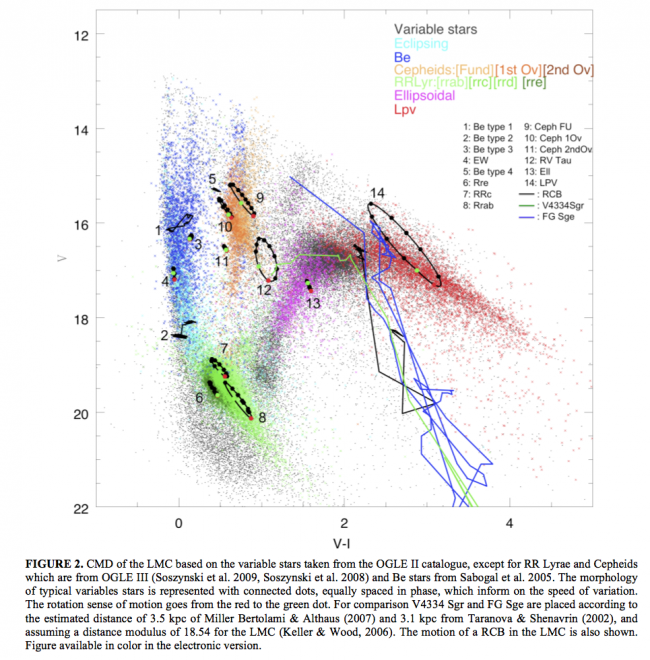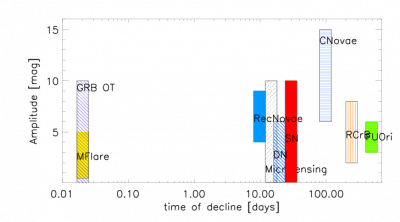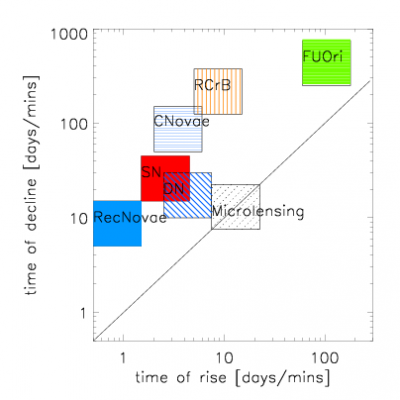Difference between revisions of "Triggers"
From Gaia Science Alerts Working Group
Jump to navigationJump to searchAleks.scholz (talk | contribs) |
|||
| Line 13: | Line 13: | ||
* [[Triggers:DNe | Dwarf novae]] | * [[Triggers:DNe | Dwarf novae]] | ||
| − | * [[Triggers:FUOri | | + | * [[Triggers:FUOri | Eruptive young stellar objects]] |
| + | |||
| + | * [[Triggers:YSOecl | Eclipsing young stellar objects]] | ||
* [[Triggers:GRBs | Gamma Ray Bursts Optical Counterparts]] | * [[Triggers:GRBs | Gamma Ray Bursts Optical Counterparts]] | ||
Revision as of 14:20, 19 July 2013
Please expand this section with your favourite types of possible alerts. The most useful information would be the number statistics, amplitude and timescale, example light curve, spectrum and the reasoning for an rapid alert.
Possible triggers for Science Alerts
Table of transients
This table is based on Rau et al. 2009 on Palomar Transient Factory (PTF). MR is an absolute magnitude in R, tau is time of a decline by 2 mag. Note, these are not all the types of transites Gaia will detect.
| Class | MR | tau | Universal rate | Gaia rate |
|---|---|---|---|---|
| Dwarf Novae | 9..4 | 3..20 | <math>3\times10^{-5} \textrm{pc}^{-3} \textrm{yr}^{-1}</math> | |
| Classical Novae | -5..-10 | 2..100 | <math>2\times10^{-10} \textrm{yr}^{-1}\textrm{L}_{\odot,K}^{-1}</math> | |
| Luminous Red Novae | -10..-14 | 20..60 | <math>1.5\times10^{-13} \textrm{yr}^{-1}\textrm{L}_{\odot,K}^{-1}</math> | |
| Fallback SNe | -4..-21 | 0.5..2 | <math>10^{-13} \textrm{yr}^{-1}\textrm{L}_{\odot,K}^{-1}</math> | |
| Macronovae | -13..-15 | 0.3..3 | <math>10^{-4..-8} \textrm{Mpc}^{-3} \textrm{yr}^{-1}</math> | |
| SN .Ia | -15..-17 | 2..5 | <math>(4..10)\times 10^{-6} \textrm{Mpc}^{-3} \textrm{yr}^{-1}</math> | |
| SNe Ia | -17..-19.5 | 30..70 | <math>3\times 10^{-5} \textrm{Mpc}^{-3} \textrm{yr}^{-1}</math> | |
| Tidal disruption flares | -15..-19 | 30..350 | <math>10^{-6} \textrm{Mpc}^{-3} \textrm{yr}^{-1}</math> | |
| Core-collapse SNe | -14..-21 | 20..300 | <math>5\times 10^{-5} \textrm{Mpc}^{-3} \textrm{yr}^{-1}</math> | |
| Luminous SNe | -19..-23 | 50..400 | <math>10^{-7} \textrm{Mpc}^{-3} \textrm{yr}^{-1}</math> | |
| Orphan afterglows (SGRB) | -14..-18 | 5..15 | <math>3\times 10^{-7..-9} \textrm{Mpc}^{-3} \textrm{yr}^{-1}</math> | |
| Orphan afterglows (LGRB) | -22..-26 | 2..15 | <math>3\times 10^{-7..-9} \textrm{Mpc}^{-3} \textrm{yr}^{-1}</math> | |
| On-axis LGRB afterglows | ..-37 | 1..15 | <math>4\times 10^{-10} \textrm{Mpc}^{-3} \textrm{yr}^{-1}</math> |
CMD of selected variables and transients
CMD paths of various types of variable stars, including Be stars, R CrB and V4334 Sgr. From Spano et al. 2009





